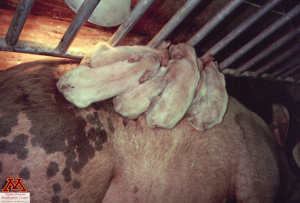Enteric System: Pre-Weaning Pigs
Coronaviruses: TGE and PED
Clinical importance
Coronaviridae, an ever-evolving family of viruses better known as coronaviruses, is a large and diverse group, causes a range of symptoms. In this chapter, we are focusing on the enteric diseases affecting swine: Transmissible Gastroenteritis (TGE) and Porcine Epidemic Diarrhea (PED). Coronaviruses are typically highly contagious and spread quickly in colder environments. Suckling piglets are at an increased risk for developing disease, characterized by vomiting, diarrhea, and high mortality. Clinical cases of TGE used to be common in the 1990s but are now more sporadic since all-herd exposure is effective in eliminating the virus from farms. On the contrary, PED was introduced from China in 2012, creating major economic losses in the US herds that were naive, by killing over 8 million pigs in barely 2 years. Since then, the virus has become endemic in parts of the industry.
Etiology and Transmission
Coronaviruses are enveloped RNA viruses which get their name from surface glyco-proteins forming crown-like projections. Transmission of the virus is mainly feco-oral but the virus can also by transmitted through aerosols. Contaminated environment is also a risk for disease transmission. The amount of PED virus shed by infected animals is extremely high and result in astonishingly high viral loads in the environment which can infect new pigs. Pigs infected with Porcine Respiratory Coronavirus (PRCV), a virus causing no symptoms or very mild sneezing, produce antibodies that can also provide cross-protection against TGE.
Which coronavirus was introduced in the US in 2012?
- Transmissible Gastroenteritis virus
- Porcine Respiratory Coronavirus
- Porcine Epidemic Diarrhea
Associated symptoms

Clinical signs associated with TGE and PED are similar. Suckling piglets before weaning are the most affected by the disease, displaying vomiting, diarrhea and high mortality due to dehydration (100% in naive herds). However, both viruses can cause diarrhea in all age pigs. In growing and adult pigs, the diarrhea will be mild to moderate in severity and resolve by itself in around a week. Both TGE and PED viruses attach and replicate in the epithelial cells of the vili, creating cell death and atrophy of the villi. Therefore, PED and TGE are both the cause of malabsorptive diarrhea.
What are the clinical signs associated with a PED or TGE infection?
- Yellowish diarrhea and thin-walled intestines
- Diarrhea, vomiting, and high mortality rate
- Hemorrhagic diarrhea and high mortality rate
Associated lesions
Macroscopic lesions
Lesions associated with TGE and PED are thin-walled jejunum and to a lesser extent ileum. The content of the small intestine is watery and yellowish in color. Mesenteric lymph nodes can be enlarged.
Microscopic lesions
Microscopic lesions of the small intestine mainly include atrophic villi.

Intestinal cut showing normal vili (left) and vili atrophy due to TGE (right). | Source: Dr. Carlos Pijoan
Diagnosis
RT-PCR on fecal samples and intestinal tissues has become the test of choice in the field. It allows for a quick turn-over of the results and differentiates between TGE and PED.
( https://www.healthtalk.umn.edu/2013/07/23/u-of-m-researchers-unveil-nations-first-porcine-virus-rapid-detection-test/ )
Differential diagnosis
With a clinical presentation very similar to rotavirus infections, PED and TGE are differentiated by vomiting and high mortality. Colibacillosis, infection by Clostridia and coccidiosis should also be included in the differential.
Treatment, Prevention and Control
No treatment is available to target TGE and PED viruses. Limiting the impact of the clinical signs, particularly dehydration, by giving the piglets water and electrolytes is one of the most effective options. Additionally, ensuring that piglets do not get chilled by making sure that they stay dry is helpful to limit the mortality rate.
Coronaviruses are enveloped virus and are therefore, sensitive to most disinfectants. However, the high viral contamination of the environment, especially in the case of PEDv can make cleaning and disinfection of the farrowing rooms challenging.
Control of coronaviruses is obtained by exposing the entire herds to the virus. The feedback method is most often used as vaccination has not been proven to be consistently effective. Farm workers collect fecal matter and intestinal content from affected piglets, dilute it with saline and feed it to the dam in order to expose them to the farm viral strains. Sows then develop immunity and pass it to the piglets through the colostrum. After a while, all of the sows are resistant to the virus and the piglets become negative. In addition to tight biosecurity and the introduction of naive gilts, this is how TGE was eliminated from US herds.
The feedback technique has been used to control PED as well. However, due to the higher viral load in the environment, some farms have had issues eliminating the virus completely and have chosen to remain positive in an endemic situation.
What is the best way to control TGE and PED in a herd?
- Treat all the sows with an antiviral to decrease the viral load in the environment
- Feedback the sows with fecal matter from infected piglet
- Vaccinate all of the herd to increase the production of antibodies in the colostrum

